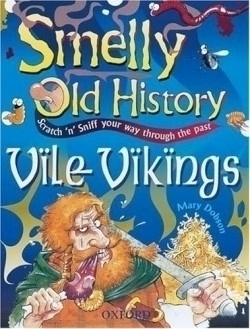Smelly Old History
Vile Vikings
A cleverly conceived slant on history for children, ages 6-13, the Smelly Old History series (nine total in the series), explores three ancient civilizations in these new releases. The earthier aspects of long-ago cultures which are of burning interest to children—such as human waste, warfare, bodily decoration and corpses—are all pungently addressed in a straightforward, kid-to-kid tone which alternately disgusts and fascinates the reader.
Largely cartooned by illustrators Vince Reid and Chris Smedley with occasional supplementary photographs in black-and-white, the books ably depict the seamier, stinkier sides of life, such as battles, body odor and death, without graphic overkill or offensiveness.
One drawback is the too-similar smell of many of the scratch ‘n’ sniff patches. A wider variety of examples—beyond the disgusting—would have been nice, such as a whiff of cedar gum, commented upon, but not provided, in the Mouldy Mummies book. Fortunately, the books are sealed individually in plastic; once opened, they off-gas a distinct, ubiquitous odor, which may be the foundation chemical used in the olfactory recipes.
Deciphering British slang such as “loo” (the bathroom) or “pong” (big bad smell), children may relish the slight foreign flavor such linguistic differences provide. Overall, they will enjoy the gross-out nature and slightly taboo content of the books. Parents will likely be more reluctant to smell scratch ‘n’ sniff patches such as the one labeled “horse manure” from Greek Grime, but their consolation prize is the avid interest with which kids will read these quick, yet sensual tours of history.
Reviewed by
Josephine Arrowood
Disclosure: This article is not an endorsement, but a review. The publisher of this book provided free copies of the book to have their book reviewed by a professional reviewer. No fee was paid by the publisher for this review. Foreword Reviews only recommends books that we love. Foreword Magazine, Inc. is disclosing this in accordance with the Federal Trade Commission’s 16 CFR, Part 255.

